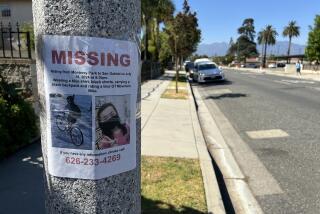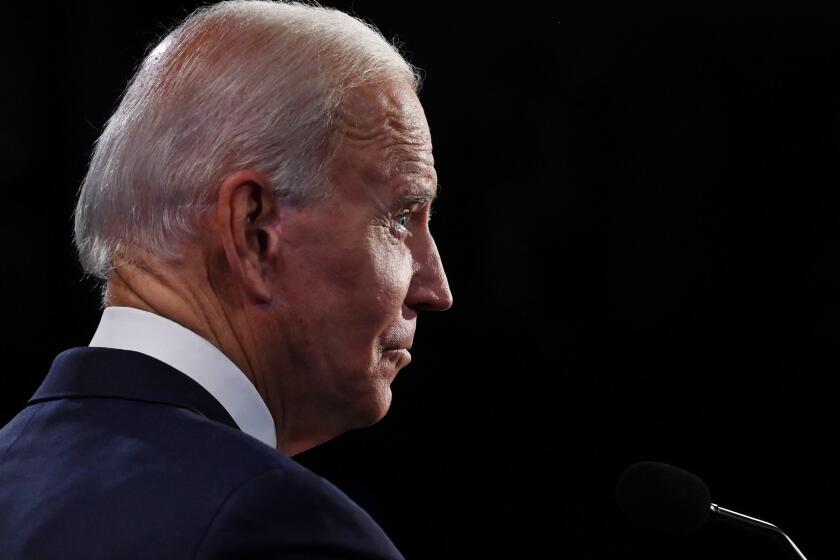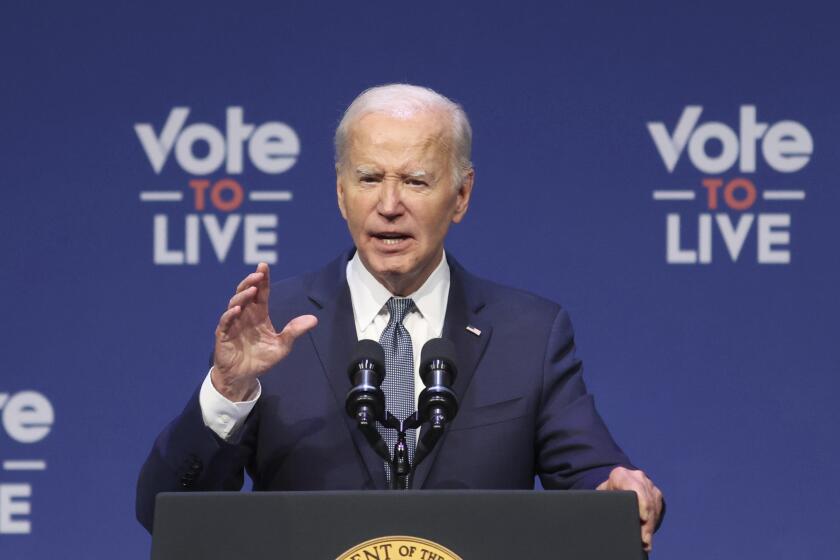Clinton Signs Bill Eliminating 55 M.P.H. Limit
Amid concern for the safety of the nation’s motorists, a reluctant President Clinton on Tuesday signed a GOP-backed initiative to eliminate federal speed limits to avoid holding up $6.5 billion in transportation funds.
Individual states will be able to set their own speed limits when the bill takes effect 10 days from now. California motorists can expect limits of 65 m.p.h. and 70 m.p.h. on thousands of miles of freeways starting in January, state officials said.
Safety advocates complained loudly, charging that Clinton was signing a death warrant for American motorists.
California Department of Transportation spokesman Jim Drago said that between 2,000 and 2,500 miles of California freeway currently designated at 55 m.p.h. are likely candidates to receive a 65 m.p.h. limit. Another 1,384 miles of freeway now restricted to 65 m.p.h. are contenders for the 70 m.p.h. top speed limit. The limit on California highways other than freeways will rise to 65 m.p.h.
Drago said it was uncertain which freeways will be affected, but generally it will be rural roadways.
He also cited the Foothill Freeway (Interstate 210), which runs mostly through foothill communities from the San Fernando Valley to Pomona, as a “logical candidate” for a higher speed.
Drago said department engineers and experts from the California Highway Patrol already have begun discussing the roads that can get higher limits. Before a decision is made on a particular highway, the state will do traffic safety and engineering studies, he added.
In September, the Legislature enacted a measure enabling restoration of the higher limits beginning in January, and Gov. Pete Wilson signed it into law.
In Washington, White House Press Secretary Mike McCurry said the Administration doesn’t “think there’s a persuasive case for raising the current maximum speed limit based on public safety and public health issues.”
But Clinton agreed to sign the National Highway System Bill--which provides funding for 160,000 miles of the nation’s roads, fearing the Administration would lose any battle with Capitol Hill over the speed limit measure.
Citing “overwhelming support” in the House and Senate for the legislation, McCurry noted: “There’s not a certainty that any veto that he would exercise would be sustained by the Congress.”
“President Clinton is about to join the Congress in supporting legislation that his own Department of Transportation says will kill and injure tens of thousands more Americans on the highways every year and cost the nation more than $19 billion a year,” consumer advocate Ralph Nader said in a statement released Tuesday before Clinton signed the measure into law.
In 1974, with gasoline prices rising as a result of the Middle East oil embargo, Congress attempted to curtail consumption by imposing a 55 m.p.h. limit on all national highways.
States that ignored the federal guidelines would be refused some federal funds.
But the law produced a welcome side-effect: 9,000 fewer highway fatalities were reported the following year.
Then in 1987, Congress relaxed the restriction and allowed states to set 65 m.p.h. speed limits on rural interstate highways.
Earlier this year, the GOP-led Congress voted to do away with all restrictions.
Employing a “state’s rights” argument, federal lawmakers said governors--not federal officials--should be the sole authority for establishing maximum highway speeds within their states and that federal highway funds shouldn’t be a hammer to pound a state legislature into compliance with a national speed limit.
The new federal law also will discontinue a policy of reducing road funding to states that do not require motorcycle riders to wear helmets and will repeal a requirement that states use shredded tires in highway construction material.
“For three decades, we’ve enjoyed bipartisan presidential leadership in advancing highway safety,” said Judith Lee Stone, president of Advocates for Highway and Auto Safety, a Washington lobbying group. She cited President Richard Nixon’s support for the 55 m.p.h. speed limit, President Gerald R. Ford’s programs for school bus safety, President Jimmy Carter’s push for air bags in cars, President Ronald Reagan’s signing of the legislation to make 21 the nation’s legal drinking age and President George Bush’s support for a federal motorcycle helmet law.
“Congress and President Clinton are undoing many of these bold advances, ensuring that thousands more Americans will die each year on our nation’s highways,” Stone said in the statement.
According to a study by Advocates for Highway and Auto Safety, a Washington industry lobby, nine states--including California--have plans under way to increase their speed limits.
The safety group’s study also found 26 other states to be “high risk” because they raised their speed limits to 65 m.p.h. on rural interstate highways within six months of the 1987 change in the federal law.
Andy Paven, a Transportation Department official, said the Administration supported the legislation because of the federal funding it provides for the nation’s highways.
“The 160,000 miles of highways covered by the authorization bill covers only 4% of the nation’s highways. But they carry 40% of all traffic, 75% of heavy truck traffic and 80% of all tourist traffic,” he said. “We didn’t want to put that in jeopardy.”
Paven said the Administration still supports a 55 m.p.h. speed limit because it is a proven safety measure that saves lives. But officials will now argue for the speed limits in direct discussions with state leaders. “We intend to work with our state partners to continue the Administration’s commitment to safety,” he said, adding the Administration didn’t have a formula for computing speed increases and highway fatalities.
“I’ve seen some of the figures put out by some of the safety groups, but no one knows that figure for certain,” he said.
But David F. Snyder, assistant general counsel of the American Insurance Assn., cited the Transportation Department as his group’s source for the costs associated with an increase in highway speed.
“Motor vehicle crashes are the No. 1 cause of death and injury for all Americans between the ages of 5 and 35,” he said in a statement released after the White House said it would sign the legislation. “This bill could result in more than 6,000 additional deaths every year, according to figures we received from the U.S. Department of Transportation, and over $19 billion in extra cost to taxpayers and insurance policy holders.”
Times staff writer Carl Ingram in Sacramento contributed to this story.
(BEGIN TEXT OF INFOBOX / INFOGRAPHIC)
Speed Limits in the West
Here is what Western states plan now that the federal 55 m.p.h. speed limit is ending:
* ARIZONA: Increase limit to 75 on rural stretches.
* CALIFORNIA: Bill signed by Gov. Pete Wilson raises maximum limit to 70 on some interstates and 65 on other highways.
* COLORADO: Lawmakers to consider bill raising maximum limit to 75 in January. Expected to pass.
* IDAHO: No immediate change planned. Current maximum speed limit is 65.
* MONTANA: Law reverts to unspecified “reasonable and prudent” standard in the day and a nighttime limit of 65 on interstates, 55 on other highways. Current maximum is 65 on the highway, 55 on non-interstate.
* NEVADA: Increase limit to 75. Current maximum is 65.
* NEW MEXICO: Legislature likely to consider increasing speed limit to 75. Current maximum is 65 on rural interstates, 55 elsewhere.
* OREGON: Lawmaker plans to introduce legislation in February that could raise limit to as much as 75. Current maximum is 65 on rural highways, 55 elsewhere.
* TEXAS: Considering proposal to raise limit to 70. Current limit is 65 on rural interstates, 55 elsewhere.
* UTAH: Legislature expected to raise limit to 70 in January. Current limit is 65.
* WASHINGTON: Increase likely, although not higher than 70. Current maximum is 65.
* WYOMING: Will rise to 75 on interstate highways, 65 on all others Dec. 8. Current limit is 65 on interstates, 55 on others.
Associated Press
More to Read
Sign up for Essential California
The most important California stories and recommendations in your inbox every morning.
You may occasionally receive promotional content from the Los Angeles Times.






